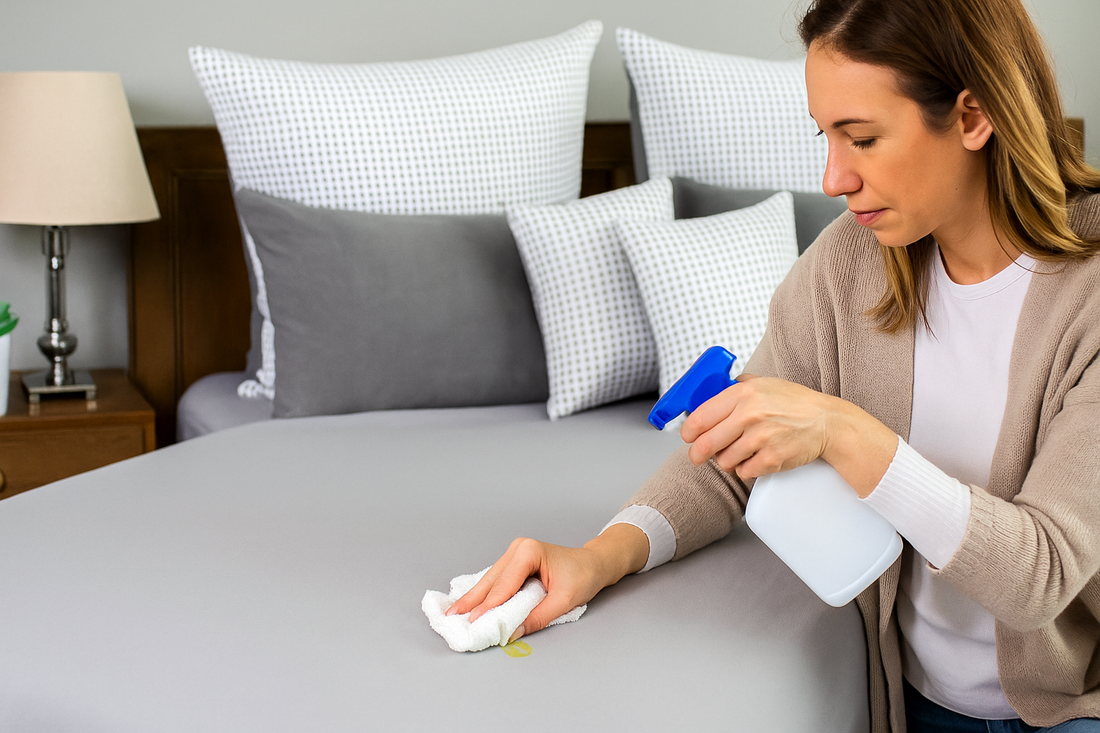Stains on bedsheets are a common problem—spilled coffee, makeup marks, sweat patches, or even pet accidents. While it’s tempting to reach for strong chemical cleaners, these can damage the fabric, fade colors, and irritate sensitive skin. Thankfully, there are safe and effective ways to clean your sheets without relying on harsh chemicals.
Here’s how you can naturally remove stains and keep your sheets looking fresh.
Why Avoid Harsh Chemicals on Your Bedsheets
Bedsheets are in close contact with your skin for hours every night. Harsh chemicals like bleach can leave behind residues that may cause irritation or allergic reactions. Over time, they can also weaken fabric fibers, making sheets thin and rough. Choosing gentle, natural cleaning methods helps maintain both fabric quality and your comfort.
Understanding Different Types of Stains
Not all stains are the same—and the way you treat them matters.
-
Protein-based stains (like blood, sweat, or food) need cool water and gentle cleaning to avoid setting.
-
Oil-based stains (like lotions or makeup) require an absorbent cleaner to lift grease.
-
Tannin stains (like tea, coffee, or wine) respond well to mild acids like lemon juice or vinegar.
Knowing the stain type helps you choose the most effective natural method.
The Power of Cold Water for Fresh Stains
When a stain happens, act quickly. Cold water is your best friend for fresh marks—especially protein-based stains. Rinse the affected area under cold running water as soon as possible. This helps wash away much of the stain before it sets into the fibers.
Tip: Never use hot water first—it can “cook” the stain and make it harder to remove.
Baking Soda: A Gentle yet Effective Cleaner
Baking soda is one of the easiest and safest stain removers you can find in your kitchen. It works as a natural deodorizer and mild abrasive that lifts stains without damaging fabric.
How to use:
-
Sprinkle baking soda directly on the damp stain.
-
Gently rub with your fingers or a soft cloth.
-
Let it sit for 30 minutes before rinsing with cold water.
For tougher stains, make a paste with baking soda and water, apply it to the area, and leave it for an hour before washing.
Using White Vinegar to Lift Stains Naturally
White vinegar is a natural acid that helps break down stain particles and brighten fabrics. It’s especially effective on tannin stains like coffee or tea.
How to use:
-
Mix equal parts white vinegar and cold water.
-
Dab the mixture onto the stain with a clean cloth.
-
Let it sit for 15–20 minutes, then rinse thoroughly.
Vinegar can also be added to your regular wash cycle to refresh and soften your sheets.
Lemon Juice for Brightening and Stain Removal
Lemon juice is a natural bleaching agent that works well for light-colored sheets. It helps break down stains and brightens fabric at the same time. To use it:
-
Squeeze fresh lemon juice directly onto the stain.
-
Let it sit for 15–20 minutes in the sun for extra whitening.
-
Rinse with cold water and wash as usual.
Tip: Avoid using lemon juice on dark-colored sheets, as it may lighten the fabric.
Salt and Water Paste for Tough Spots
Salt is great for absorbing moisture and gently scrubbing away stubborn marks. For stains like wine or sweat:
-
Mix equal parts salt and cold water to create a paste.
-
Apply it to the stain and rub gently with your fingers.
-
Let it sit for 30 minutes, then rinse and wash.
This method works best when used soon after the stain appears.
How to Treat Oil and Grease Marks Naturally
Oil stains can be tricky, but baking soda works wonders. It absorbs excess grease and loosens it from the fabric.
-
Sprinkle baking soda directly over the oil spot.
-
Let it sit for 15–30 minutes to absorb the grease.
-
Brush off the powder and wash in warm (not hot) water.
If the stain is still visible, repeat the process before drying.
Drying Tips to Prevent Stain Setting
The way you dry your bedsheets can make or break stain removal. Heat can set stains permanently, so always air dry your sheets after cleaning until you’re sure the mark is gone. If you use a dryer, choose a low-heat setting.
Tip: Sun-drying is a natural way to brighten light-colored sheets and help kill bacteria.
Preventing Future Stains on Your Bedsheets
Prevention is always easier than stain removal. You can protect your bedsheets by:
-
Using a mattress protector and pillow protectors.
-
Avoiding eating or drinking in bed.
-
Washing sheets regularly to prevent sweat and dirt buildup.
- Treating any mark immediately instead of waiting until laundry day.
These habits keep your sheets looking newer for longer.
Suggested Article: Best Ways to Wash and Store Cotton Bedsheets
Conclusion
You don’t need harsh chemicals to keep your bedsheets clean and stain-free. Simple ingredients like cold water, baking soda, and white vinegar can handle most everyday stains while protecting the fabric and your skin. Acting quickly, choosing the right method for each stain, and using gentle cleaners will help your sheets look fresh and last longer.
At Loom Home Textiles, we believe in caring for your home textiles the natural way—so they stay beautiful, soft, and safe for years to come.





